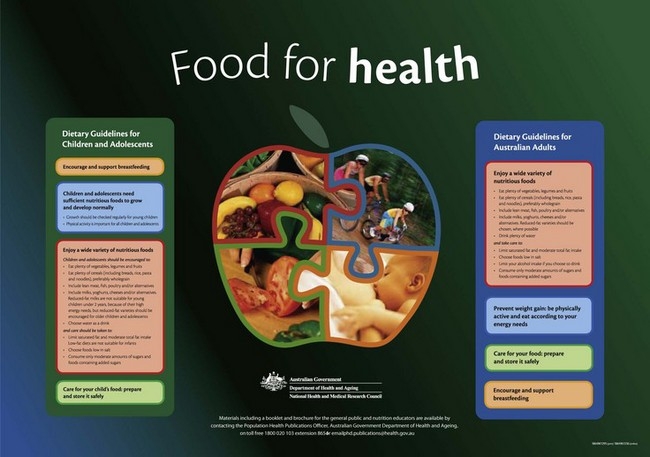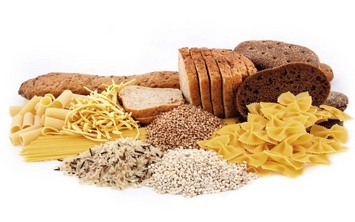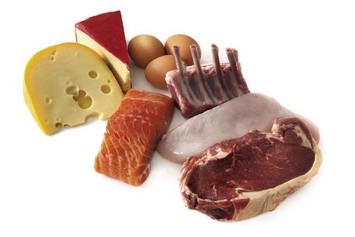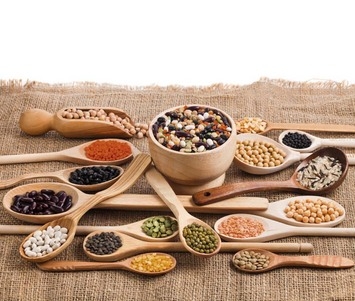Chapter Four Sports nutrition
Demonstrate a sound knowledge and understanding of basic nutrition for athletes.
1. Explain the general guidelines of food and nutrition for athletes.
2. Explain the relationship between nutrition and health to athletes.
3. Collect information on the different dietary strategies for optimising an athlete’s body composition and sporting performance.
4. Explain the basic components of a balanced diet that fulfils the training needs of an athlete.
5. Explain the basic dietary requirements for an athlete’s competition and recovery.
6. Interpret the nutritional information presented on food packaging.
Assessment of outcomes
Practical demonstration
You may be asked to explain the nutrition value of certain foods to your class or instructor.
Food for Health dietary guidelines
Dietary guidelines were released by the Australian Government Department of Health and Ageing and the National Health and Medical Research Council (NHMRC) in 2005 in their booklet, Food for Health. The guidelines promote healthy eating as well as the importance of leading a physically active lifestyle. The booklet is free to download from the NHMRC website (www.nhmrc.gov.au). It contains information and recommendations by experts about food groups and lifestyle patterns that promote good nutrition and health at each of the stages of a person’s life when dietary needs are different.
The Dietary Guidelines for Australian Adults recommend that adults should:
 eat plenty of vegetables, legumes and fruits
eat plenty of vegetables, legumes and fruits
 eat plenty of cereals (including breads, rice, pasta and noodles), preferably wholegrain
eat plenty of cereals (including breads, rice, pasta and noodles), preferably wholegrain
 include lean meat, fish, poultry and/or alternatives
include lean meat, fish, poultry and/or alternatives
 include milks, yoghurts, cheeses and/or alternatives. Reduced-fat varieties should be chosen, where possible
include milks, yoghurts, cheeses and/or alternatives. Reduced-fat varieties should be chosen, where possible
Adults should also take care to:
 limit saturated fat and moderate total fat intake
limit saturated fat and moderate total fat intake
 limit their alcohol intake if they choose to drink
limit their alcohol intake if they choose to drink
 consume only moderate amounts of sugars and foods containing added sugars.
consume only moderate amounts of sugars and foods containing added sugars.
 eat plenty of vegetables, legumes and fruits
eat plenty of vegetables, legumes and fruits
 eat plenty of cereals (including breads, rice, pasta and noodles), preferably wholegrain
eat plenty of cereals (including breads, rice, pasta and noodles), preferably wholegrain
 include lean meat, fish, poultry and/or alternatives
include lean meat, fish, poultry and/or alternatives
 include milks, yoghurts, cheese and/or alternatives. Reduced-fat milks are not suitable for young children under 2 years because of their high energy needs, but reduced-fat varieties should be encouraged for older children and adolescents
include milks, yoghurts, cheese and/or alternatives. Reduced-fat milks are not suitable for young children under 2 years because of their high energy needs, but reduced-fat varieties should be encouraged for older children and adolescents
 choose water as a drink. Alcohol is not recommended for children.
choose water as a drink. Alcohol is not recommended for children.
In addition, care should be taken to:
Carbohydrate
Carbohydrates are grouped as either:
 simple carbohydrates – also known as simple sugars (e.g. white sugar)
simple carbohydrates – also known as simple sugars (e.g. white sugar)
 complex carbohydrates – also known as starches (e.g. bread and rice).
complex carbohydrates – also known as starches (e.g. bread and rice).
Protein
Proteins fall into two classes:
1. Complete proteins (containing all nine essential amino acids) are found in animal-based protein products; for example, red meat, fish, poultry and dairy foods.
2. Incomplete proteins (lacking in one or more essential amino acids) are found in plant-based protein products; for example, nuts, legumes, tofu, soy products, breads and cereals. However, protein foods can be ‘complemented’ to ensure all amino acids are obtained from the diet. This is especially important for vegetarian athletes.
Stay updated, free articles. Join our Telegram channel

Full access? Get Clinical Tree















